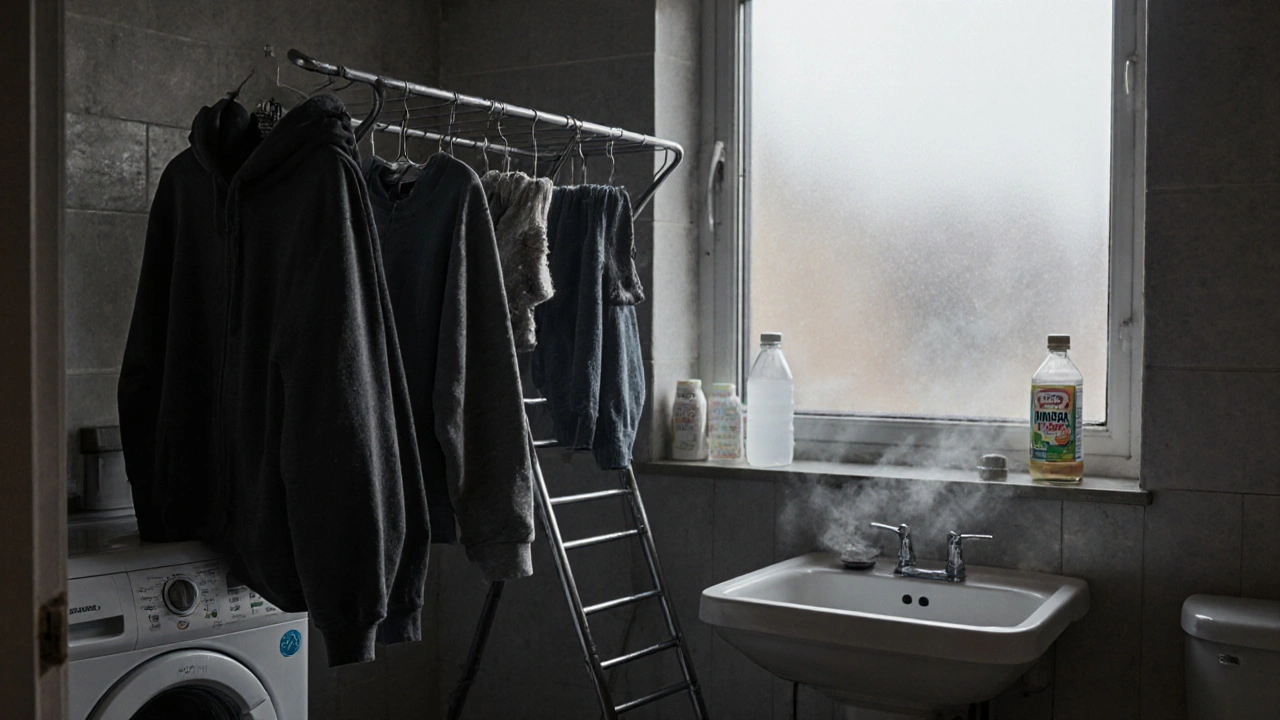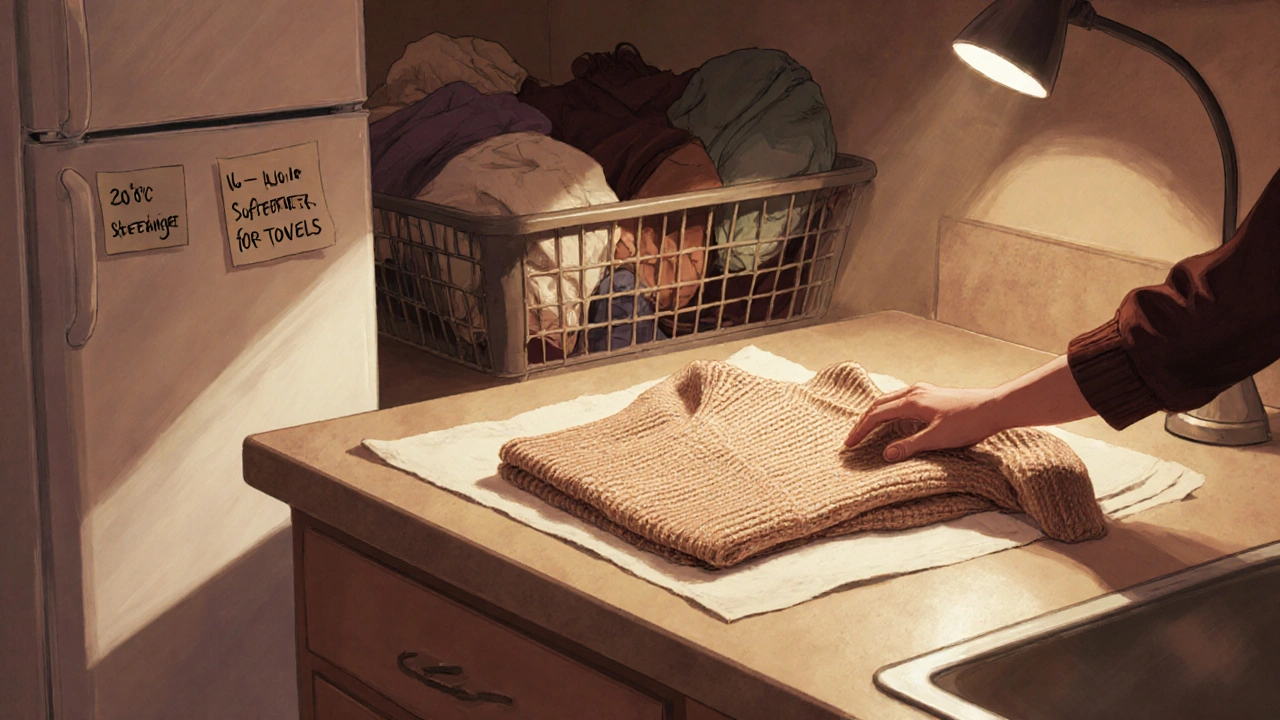
Let’s be real-no one teaches you how to do laundry properly before you move into a student flat in the UK. One week into term, you’re staring at a pile of stained socks, a weird smell coming from your hoodie, and a washing machine that might as well be a black box with buttons you don’t understand. It’s not magic. It’s not complicated. But if you don’t get it right, your clothes will shrink, fade, or turn into something unrecognizable by midterms.
Know Your Washing Machine Settings
UK student flats usually come with a washing machine that’s older than your course syllabus. It might have symbols instead of words. Don’t panic. Here’s what they actually mean:- 30°C - Your go-to for most clothes. Saves energy, protects colours, and cleans just fine. Most modern detergents work perfectly at this temperature.
- 40°C - Only use this for towels, bed sheets, or clothes that are really sweaty or dirty. Higher heat kills germs but fades colours faster.
- 60°C - Reserved for underwear, socks, or if someone in your house has been sick. This is overkill for 95% of your wardrobe.
- Spin speed - 1200-1400 RPM is standard. Higher spin = less drying time. Don’t go above 1600 unless your clothes are heavy-duty (like jeans or towels).
- Delicate cycle - Use for knits, lace, or anything with embellishments. If it feels flimsy, treat it gently.
Always check the care label inside your clothes. A circle with a dot inside means tumble dry. A square with a curved line means air dry. A triangle means bleach is okay. If it’s crossed out? Don’t do it.
Detergent, Fabric Softener, and the Truth About Pods
You’ve probably seen those colourful detergent pods. They look cool, but they’re not always the best choice. Here’s what actually works:- Laundry pods - Convenient, yes. But they often contain too much detergent for small loads. You’ll end up with residue on your clothes and a slimy buildup in your machine. Use them only for full loads.
- Liquid detergent - Best for precision. Measure with the cap. Most loads need 1-2 caps, not the whole bottle.
- Powder detergent - Cheaper and good for stains. Dissolves better in warm water. Avoid it if your machine is cold-water only.
- Fabric softener - Skip it for towels. It coats the fibres and makes them less absorbent. Use it only on clothes you want to smell nice, not on anything you sweat in.
Pro tip: Add half a cup of white vinegar to the rinse cycle once a month. It removes detergent buildup, kills odours, and softens clothes naturally. No chemicals. No smell after it dries.
Drying Clothes in the UK: No Dryer? No Problem
Most student housing doesn’t have a tumble dryer. Or if it does, it costs £1.50 per cycle and takes forever. You’ll be hanging clothes indoors more than you think. Here’s how to do it without turning your flat into a sauna:- Use a drying rack - Get a foldable one that fits in the bathroom or kitchen. Don’t hang clothes on radiators unless they’re labeled "drip dry". Heat can shrink wool and damage synthetic fibres.
- Hang heavy items flat - Sweaters, hoodies, and knits should be laid flat on a towel to dry. Hanging them stretches them out. You’ll end up with a misshapen hoodie that looks like it’s been through a war.
- Use a dehumidifier - If you’re in a damp flat, a cheap one (under £50) cuts drying time by half and stops mould from growing on your walls.
- Wring out clothes first - Don’t just drop wet clothes on the rack. Twist them gently (or use the spin cycle) to remove excess water. Less water = faster drying.
Never dry clothes in your bedroom unless you want a mildew smell in your sheets. And if your room smells like a wet dog after a week of rain? You’re doing it wrong.

Ironing: When You Actually Need It (Spoiler: Rarely)
You don’t need to iron everything. Most modern fabrics are wrinkle-resistant. But here’s when you do need an iron:- Shirts for interviews or presentations - A crisp collar makes a difference. Use steam if your iron has it.
- Formal trousers or skirts - A crease adds polish. Iron on the inside to avoid shine marks.
- Bed sheets - If you’re tired of sleeping on wrinkled cotton, ironing them once a month makes your bed feel like a hotel.
For everything else? Hang clothes up right after washing. Shake them out before hanging. That’s 80% of the battle. If you still have wrinkles, toss the item in the dryer on low heat for 10 minutes with a damp towel. The steam will smooth it out.
And if you’re tempted to buy a steam iron? Don’t. A handheld steamer costs £25 and is way easier to use. Just hold it 2-3 inches from the fabric and move slowly. No ironing board needed.
Stain Removal That Actually Works
Red wine on your white shirt? Sweat marks under your armpits? Grass stains from a weekend walk? Here’s what to do before you toss it in the wash:- Red wine - Blot (don’t rub) with a clean cloth. Sprinkle salt on it. Let it sit for 10 minutes. Rinse with cold water. Wash as normal.
- Sweat stains - Mix one tablespoon of baking soda, one tablespoon of hydrogen peroxide, and one tablespoon of water. Rub it in, let it sit for 30 minutes, then wash.
- Grass stains - Rub a bit of dish soap into the stain. Let it sit for 15 minutes. Brush gently with an old toothbrush. Wash in cold water.
- Makeup - Dab with rubbing alcohol on a cotton pad. Don’t scrub. Rinse with cold water.
Never use hot water on stains. It sets them. Always start with cold. And never put a stained item in the dryer until you’re sure the stain is gone. Heat locks it in forever.

Laundry Mistakes UK Students Make (And How to Avoid Them)
Here are the top 5 mistakes you’re probably making right now:- Washing everything together - Darks with whites? You’ll end up with grey socks. Separate by colour. Use a mesh bag for delicates.
- Overloading the machine - If you can’t fit your hand between the clothes and the drum, it’s too full. Clothes need space to move to get clean.
- Leaving clothes in the machine for hours - That’s how mildew starts. Take them out within an hour of the cycle ending.
- Using too much detergent - More isn’t better. It leaves residue and attracts dirt. Follow the cap lines.
- Ignoring the lint filter - If your dryer has one (or your washing machine does), clean it after every 3-4 loads. Clogged filters = longer drying times and fire risk.
Laundry isn’t a chore if you treat it like a system. Set a day. Stick to it. Don’t let piles grow. One load every 3-4 days is enough for most students.
Laundry Checklist for UK Students
Keep this on your fridge or phone:- Sort clothes: colours, delicates, towels
- Check pockets: tissues, coins, receipts - they ruin everything
- Use cold water (30°C) for most loads
- Measure detergent - not guess
- Spin at 1200-1400 RPM
- Hang heavy items flat
- Take clothes out within an hour
- Clean lint filter every 3-4 uses
- Run a vinegar cycle once a month
Do I need to wash new clothes before wearing them?
Yes. New clothes often have chemical finishes, dyes, or dust from the factory. Wash them once before wearing to avoid skin irritation and colour bleeding. Even if the tag says "pre-washed," it’s still a good idea.
Can I wash my sneakers in the washing machine?
Some can, but not all. Remove the laces and insoles. Put them in a pillowcase or mesh bag. Use cold water and a gentle cycle with no spin. Air dry them - never put them in the dryer. The heat warps the glue and ruins the shape.
Why do my towels feel stiff after washing?
Fabric softener is the culprit. It coats the fibres and reduces absorbency. Use vinegar in the rinse cycle instead - it removes residue and leaves towels soft and fluffy. Also, avoid over-drying. Take them off the line while slightly damp and shake them out.
How often should I clean my washing machine?
Run an empty hot cycle (60°C) with a cup of white vinegar or a washing machine cleaner every month. This stops mould, mildew, and bad smells from building up inside the drum and rubber seal. If your machine smells like wet dog, it’s overdue.
Is it okay to dry clothes on a radiator?
Only if the care label says "drip dry" and the fabric is cotton or linen. Never dry wool, silk, or synthetic fabrics (like polyester) on radiators - they can melt, shrink, or warp. Use a drying rack instead. It’s safer and better for your clothes.